History of
Siu Lam Wing Chun
Where does Siu Lam Wing Chun come from?
Origin, transmission, development.
From Bodhidharma to the modern age.
Discover the fascinating history of Siu Lam Wing Chun
Welcome to our history page, where we explore the deep roots and captivating development of Siu Lam Wing Chun, a form of traditional Shaolin Kung Fu. Learn more about the origins of Wing Chun, which can be traced directly back to the teachings of the legendary monk Bodhidharma and whose influence extends to the present day. Delve into the history of this unique martial arts style, from its beginnings in the first Siu Lam temple to its worldwide spread and recognition as one of the most effective self-defense arts.
-
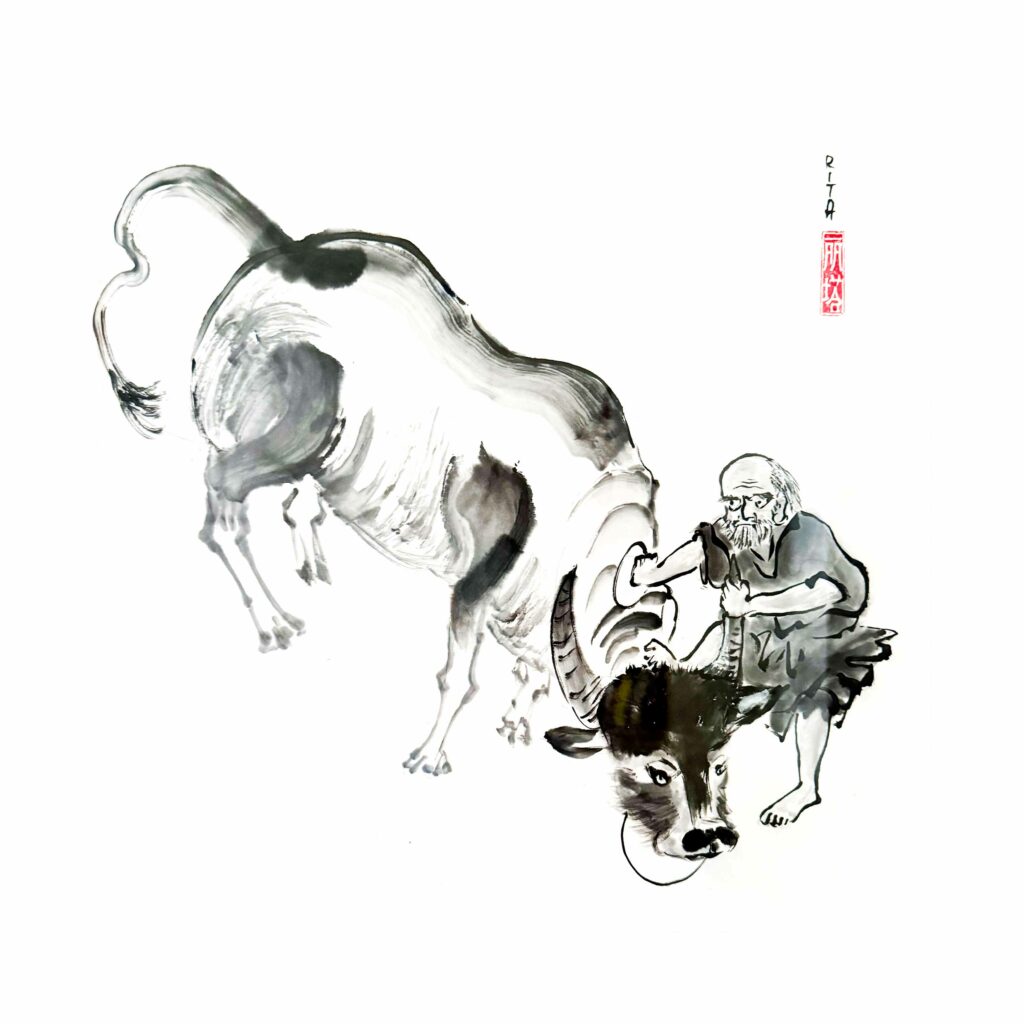
520 AD, the Indian monk Bodhidharma (菩提達摩 or Damo 達摩 for short) reaches southern China by sea
From Fujian Province in southern China, the Buddhist monk Bodhidharma (Damo) first traveled to Qingyuan in Guangdong Province and from there to northern China, in Henan Province.
Damo meditated for 9 years in front of a wall, founded Chan Buddhism1, and with it the Shaolin School2. Until then, the monks had practiced the Daoist martial art of Taiji Quan (Cantonese Tai Gik Kyun).
The temple in Henan itself was built as early as 496 AD. However, it was only with Damo’s teachings and the connection to Chan Buddhism, which is inseparable from the culture of Shaolin, that the Shaolin School in Henan was founded around 527 AD.
Gradually, the teachings of Chan spread throughout China, and several temples affiliated with the Shaolin School were established.
- Chan (禅, Meditation)
- Chan Buddhism was introduced to Japan by Dogen in 1295
- Thereafter, Japanese Zen Buddhism was formed
- Shaolin Pai (少林派, School of the Young Forest)
- Mandarin pronunciation: shǎo lín pài
- Cantonese pronunciation: siu3 lam4 paai1
- In the following text, we use the term Shaolin for the school (movement) in northern China, and the term Siu Lam for the lineage clearly attributed to southern China, especially Guangdong Province.
- Chan (禅, Meditation)
-
1368 to 1644: Ming Dynasty
The Ming Dynasty was a close ally of the Shaolin Temple, where, during this golden age of Shaolin Kung Fu, approximately 2,500 monks lived and practiced various martial arts styles.
Occasionally, Shaolin monks were called upon by the emperor to support the military in crisis regions.
-
1644: The Qing Overthrow the Ming Dynasty
The Ming Emperor managed to flee with two bodyguards.
Allies of the Ming government increasingly came under pressure and fled.
During the Qing Dynasty, the Shaolin Temple in Henan was destroyed several times.
It is widely acknowledged that the "Chinese Freemasons" were founded by a group of Shaolin monks with the goal of overthrowing the Qing Dynasty and restoring the rule of the Chinese Han people. After this time, the Chinese Freemasons spread widely and developed into many groups/lines. One of these was the Heaven and Earth Society.
A slogan of the Chinese Freemasons was passed down in the lineage of Siu Lam Wing Chun:
Speak always with determination,
Do not forget the Han people,
Spring will return永言矢志;
毋忘漢族;
大地回春Wing yun chi jee;
Mo mong Hon juk;
Dai dei wui chun1When they spoke this motto, they could clearly identify their brothers. To make it easier to use and to hide its revolutionary character from the Qing, the motto was eventually shortened to just the first and last words: 永春 (“Wing Chun”, meaning "always Spring" or "eternal Spring"). This became the name for their combat methods.1
In the transmission of the Loeng Zaan lineage, there are some differences. Firstly, there is an additional third verse: “give us back our homeland” (還我河山, waan ngo ho saan). Secondly, the whole saying was abbreviated differently, combining the first two words 永 (always) and 言 (speak) to form 詠, which means "sing a song" (also pronounced "Wing"). Thus, in the Loeng Zaan lineage, the full abbreviation and therefore the name of the martial art became 詠春, meaning "sing a song of Spring." From this lineage, the now very well-known Yip Man Wing Chun eventually developed.2
The distinction between 永春 - "eternal Spring" - of Siu Lam Wing Chun and 詠春 - "sing a song of Spring" - of Loeng Zaan Wing Chun can, however, be easily overlooked because, on the one hand, both pronunciations sound relatively similar in Cantonese, and on the other hand, both names are often written the same way in the Romanized spelling: Wing Chun.
Sources:
- Chu, Robert, René Ritchie, and Y. Wu: Complete Wing Chun, page 78. Note: The third part (還我河山) is missing here.
- https://wingchun2009.blogspot.com/2009/04/blog-post_9016.html?m=1, accessed 20.08.2024, 23:00
-
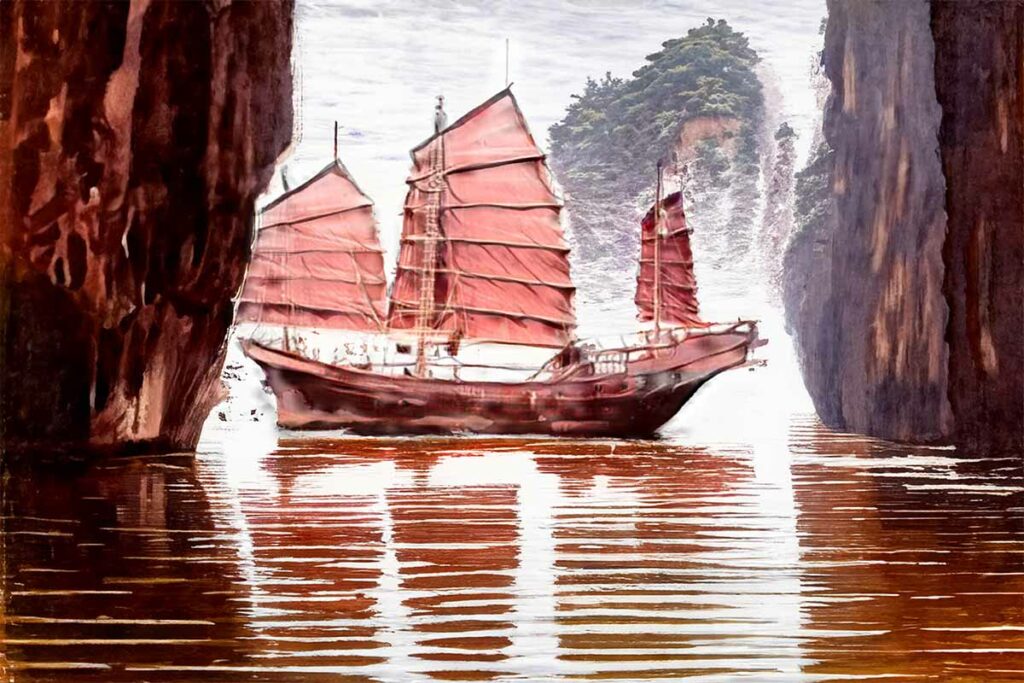
The Red Boat Opera Troupe
In the Pearl River Delta area of Guangdong, opera troupes traveled on red boats, moving from city to city to perform opera shows.
Through their stage characters, the performers of Cantonese opera expressed their discontent with the social injustices under the Qing regime. The actors of the Red Boat Troupes often became targets of persecution because they played a significant role in leading uprisings against the dynasty. In 1911, members of the troupe played a key role in overthrowing the Qing Dynasty. With the founding of the Republic, the Red Boat Troupes entered a golden age.
On the Red Junk of Wong Waa Bo, a fleeing monk who was probably a “very nice Chan master” found shelter. In legends, this monk is called Zi Sin Sin Si, which translates as “Very Nice Chan Master”. Loeng Ji Tai, the boatman, learned pole techniques from Zi Sin, as he was already familiar with handling a pole through his boat work.
A wooden dummy was also installed on the Red Boat, and Zi Sin taught the wooden dummy form and hand techniques to Wong Wah Bo.
Wong Wah Bo and Loeng Ji Tai taught San Gam, an actor in the opera troupe, who was primarily used for fight scenes due to his lack of singing ability.
-
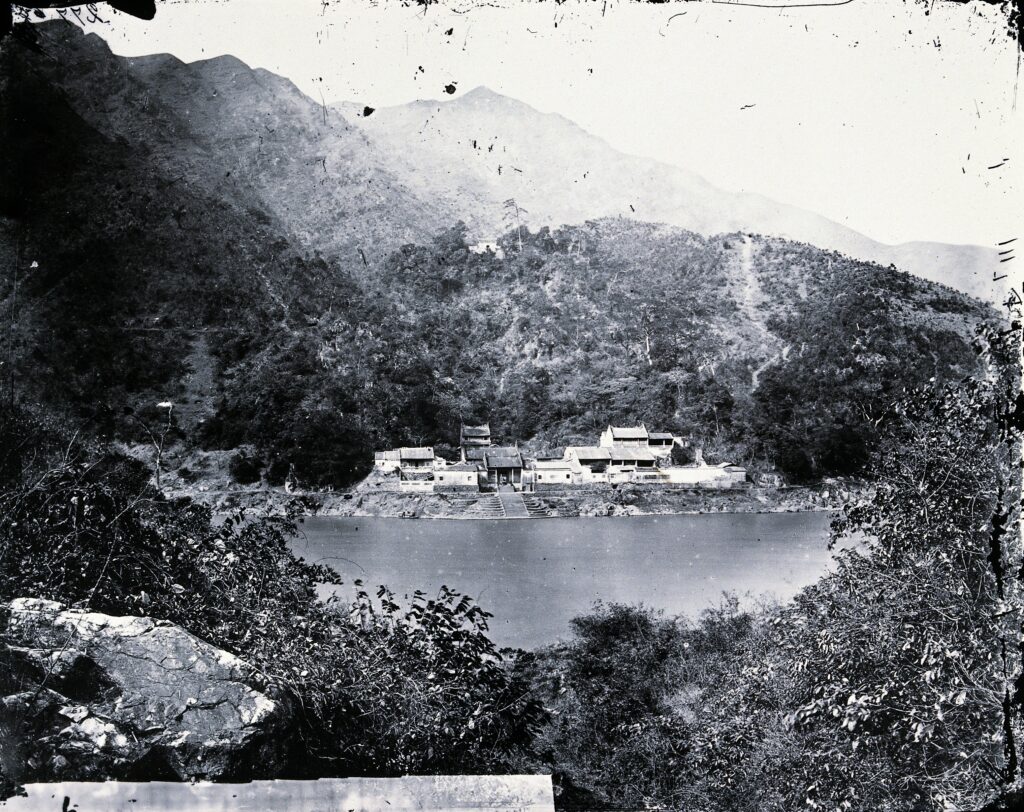
1850 Feilai Temple
The emperor of the Liang Dynasty commissioned the construction of the Feilai Temple in Qingyuan, Guangdong Province. The temple was inaugurated in 524. Damo himself passed through here on his journey from southern to northern China, and there is a stone at the site engraved with the words "Damo's Stone."
According to legend, the Shaolin monk Zi Sin sought refuge at the Feilai Temple after leaving the Red Boat. Here, he is said to have taught the Wing Chun Kyun hand form, parts of the pole techniques, and the wooden dummy form to the merchant Tang Bun, whose trade route passed by the Feilai Temple. When Zi Sin decided to move on, he sent Tang Bun to the Red Boat to learn further from Wong Wa Bo and Loeng Ji Tai. Tang Bun later sought out Loeng Ji Tai and found that the techniques and forms of the pole and wooden dummy differed slightly from what he had learned at the Feilai Temple. He eventually passed on both versions to his son Tang Zau.
The Feilai Temple was destroyed three times after 1850 and was rebuilt in the 1970s.
In 1997, a landslide washed everything into the river. Only the old gate of the original temple remains today. The reconstruction was completed in 2004.
The first written records of our martial art date back to 1852. However, due to the temple's destruction and the landslide, no records of Zi Sin's presence could be found at the Feilai Temple. Similarly, during our 2018 research, no one at the site knew of a stay by Zi Sin.
Image Source:
V0037287 A group of buildings on the river bank
Credit: Wellcome Library, London. Wellcome Images http://wellcomeimages.org
A group of buildings: houses, a temple, or a homestead, on the bank of a broad river, with mountains behind to the left. Siam Photograph 1865 - 1866 By: John Thomson Published: -
Copyrighted work available under Creative Commons Attribution only licence CC BY 4.0
-
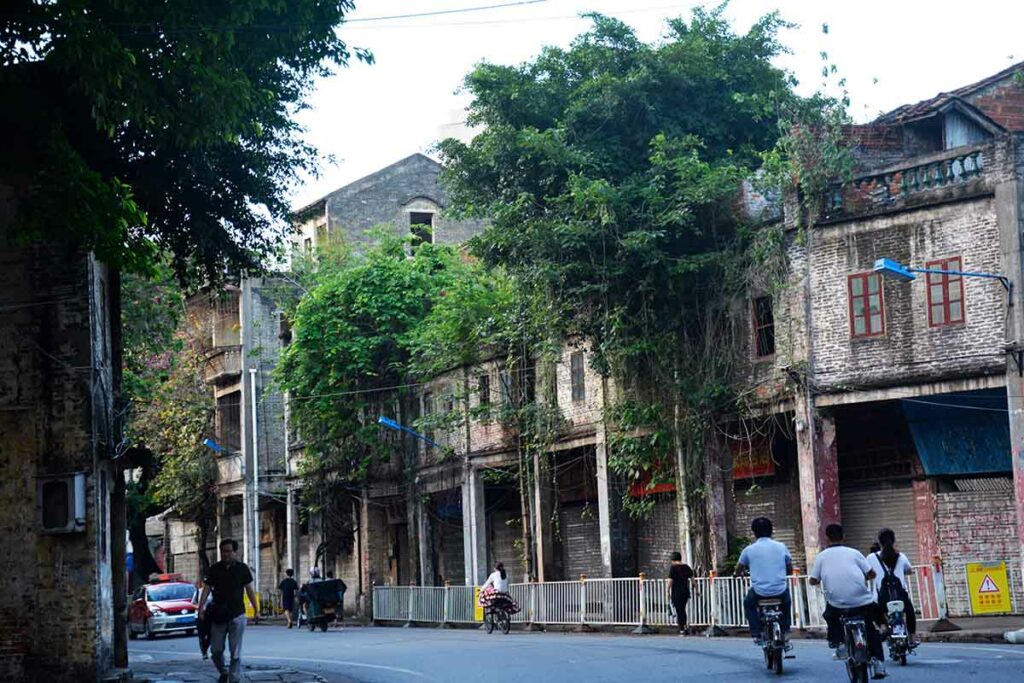
1890 The Jyun Wo Percussion Shop
Tang Syun was a student of Fung Siu Cing. Fung Siu Cing had learned Siu Lam Wing Chun on the Red Boat from San Gam. Tang Syun also studied Siu Lam Wing Chun from Tang Zau in his hometown.
The Jyun Wo Percussion Shop, owned by Tang Pok in Foshan, became a gathering place for Siu Lam Wing Chun practitioners and masters. Tang Syun taught here along with Tang Pok.
Fung Siu Cing visited, and some of his students deepened their knowledge of the long pole techniques. Here, the Soeng Gung hand form, which Tang Syun had learned from Yeung Tim, was practiced.
In total, training and teaching took place here for several decades, making it a place where several Siu Lam Wing Chun lines converged, leading to the creation of a unified curriculum.
The extensive long pole form, which is based on a variety of collected long pole techniques, was further developed here to the point that Tang Yik later learned it from his father, Tang Syun, when he was 10 years old.
-
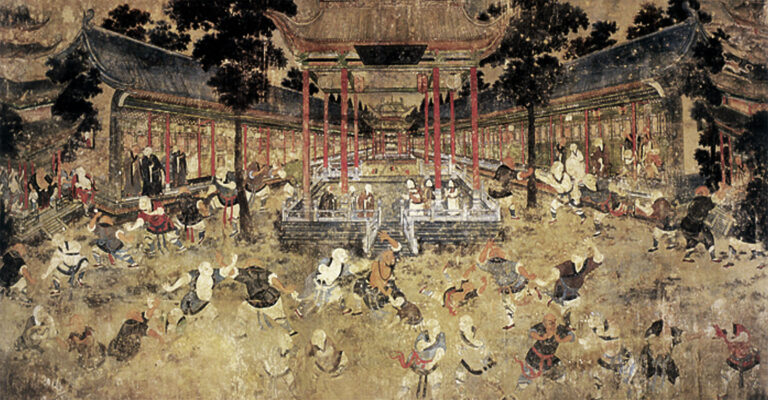
The End of Shaolin
After multiple destructions during the Qing Dynasty, the Shaolin Temple in Henan was again destroyed in 1928, this time by the Republic of China. The temple's final end came after 1949 when the Communist Party took power.
During the "Great Leap Forward," the Party forced the monks to leave the temple and reintegrate into "normal" life. The remaining Buddhist books and study materials were destroyed. The lands of the Shaolin Temple were nationalized during the four-year Great Famine, and the remaining monks could no longer sustain themselves there. Then came the Cultural Revolution. Because the temple had previously owned land, the abbot was criticized as a landlord and an enemy of the working class. By this time, only the abbot and his assistant monk were living in the temple.
It was not until after the worldwide success of the movie "Shaolin Temple" in 1982, starring Jet Li, that Shaolin regained importance for the Communist Party. The temple in Henan was rebuilt and staffed with Buddhist monks. Within the temple is the state-run Wushu school "Wushu-Guan." The acrobatic performances serve as a tourist attraction.
Image Source:
Mural from the Shaolin Temple in Henan.
The image depicts authentic training scenes from the peak of Shaolin Kung Fu. -

1940s to Mid-1960s Dai Dak Lan
The businessman Way Yan owned a poultry shop on the grounds of the fruit wholesale market in the Yau Ma Tei district of Hong Kong. The market is still located today on Waterloo Road, a side street of Nathan Road. Besides Way Yan's poultry shop, there were also other fish and grocery stores there until the mid-1960s, which were then moved to other market areas.
Way Yan was very interested in martial arts, and as a student of Siu Lam Wing Chun master Lo Chiu Wun, he learned that Tang Yik had fled to Hong Kong and had not yet found a place to stay. Since Tang Yik and the Tang family were also famous for their Siu Lam Wing Chun, Way Yan offered the upper floor of his shop as accommodation. A wooden dummy was also installed here, and in addition to Tang Yik and Lo Chiu Wun, Chu Chun Man and Taam Gong later joined the group of Siu Lam Wing Chun masters. As they spent a lot of time here, discussing and training, the four quickly became known in the Hong Kong martial arts community as the "Four Tigers of Siu Lam Wing Chun."
Tang Yik also had some students here, and the place became a popular Wing Chun insider spot. Even Yip Man, who later became very famous through his student Bruce Lee, was occasionally a guest, and it is claimed that he once accidentally fell over a chair during training.
Through the lively exchange of the Siu Lam Wing Chun masters, who came from different backgrounds, a new and up-to-date curriculum was created. As the time of the Wing Chun families was coming to an end, the essence of each lineage was to be incorporated into the common curriculum. For example, Chu Chun Man, originally from Macau, was a student of Dung Zik and Dung On, two brothers and students of Fung Siu Cing. Taam Gong was also a student of Dung Zik and Dung On. Lo Chiu Wun, on the other hand, brought the Saam Baai Fat hand form into the curriculum.
-
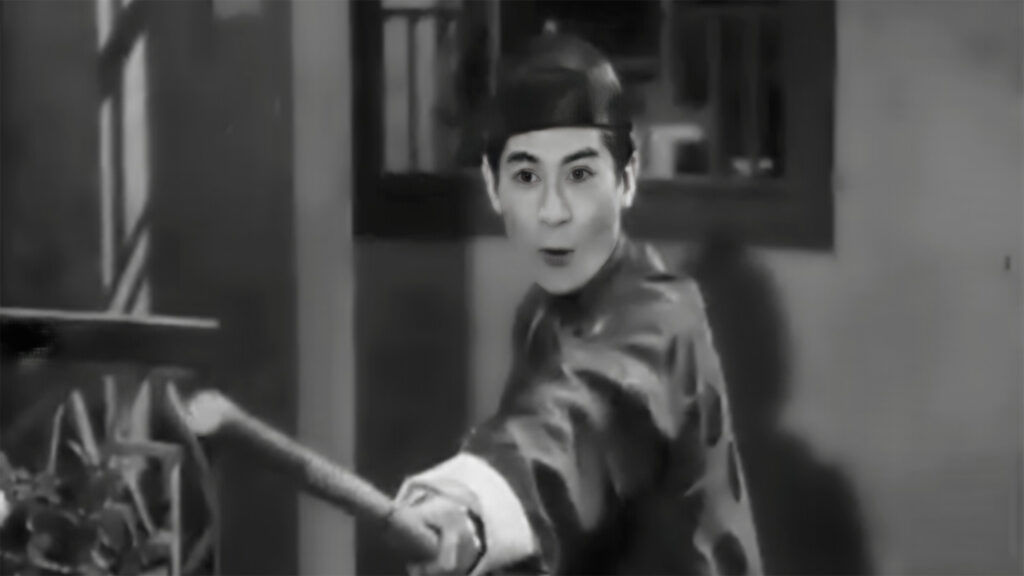
1960s Theatre Group in Nathan Road
In the 1960s, the father of the famous dramatist Lam Ka-Sing, Lam Heung Wing, admired Tang Yik's Siu Lam Wing Chun and his skill with the long pole. He invited Tang Yik to teach the artists in his theatre club on Nathan Road. After several years of teaching, the students made good progress. However, the club was closed for renovations, and the lessons were discontinued.
From then on, Tang Yik no longer taught Siu Lam Wing Chun publicly, but he gave private lessons to a few kind-hearted, talented, and long-time students like Chan Hoi Syun, Yung Tai Long, Kwong Chak Cheung, and Wong Wing Keung.
By the late 1960s, Michael Tang Chun Pak, Tang Yik's grandnephew, was also one of his students.
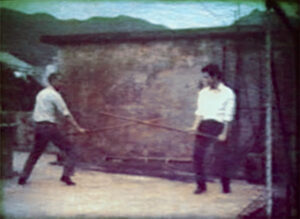 Chan Hoi Syun created an extensive set of 8mm recordings of Tang Yik, Kwong Chak Cheung, and others. Most of the recordings were taken on Yung Tai Long's rooftop in Northeast Kowloon, as shown in the still image here.
Chan Hoi Syun created an extensive set of 8mm recordings of Tang Yik, Kwong Chak Cheung, and others. Most of the recordings were taken on Yung Tai Long's rooftop in Northeast Kowloon, as shown in the still image here.Tang Yik's longest-standing student, Chan Hoi Syun, who studied under him for 25 years, does not teach himself.
Kwong Chak Cheung moved to Canada in the 1990s and died in a car accident there.
Wong Wing Keung now lives in America.
Image Source:
- YouTube 10.07.2024
https://www.youtube.com/watch?v=oieq_FlGFpk
《粵語長片合集》南龍北鳳 (1963)/ 江湖七虎 (1964)|林家聲|南紅|香港電影|香港粵語電影|粵語中字
Image of Lam Ka-Sing in the Hong Kong movie Seven Tigers from 1964 - 8mm recordings by Chan Hoi Syun
- YouTube 10.07.2024
-
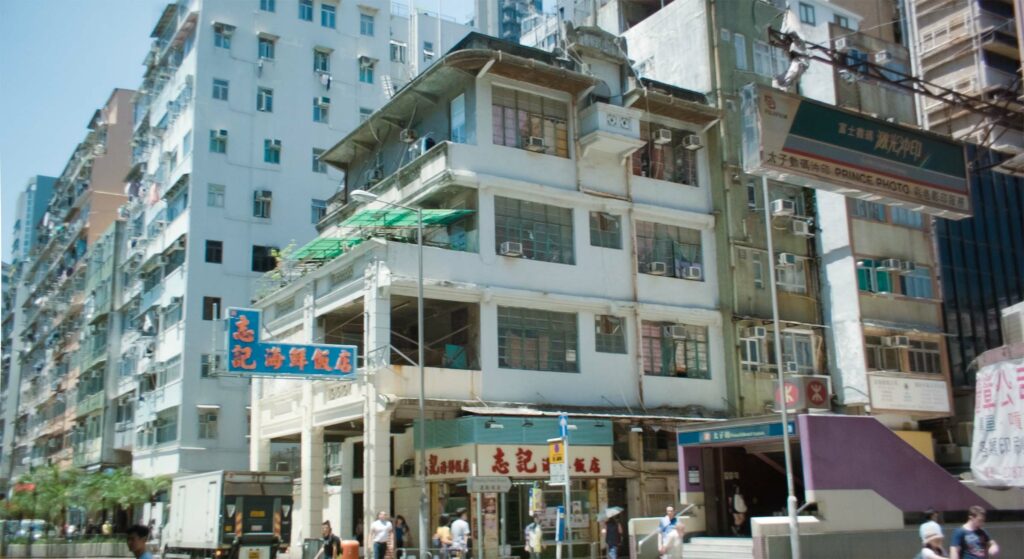
1980s Playing Fields Road
Michael Tang Chun Pak learned from his granduncle Tang Yik during the semester breaks in 1969. He grew up in the house on Playing Fields Road.
After his parents passed away early, he offered Tang Yik a place to stay, where a wooden dummy was installed in the living room.
Tang Yik lived here until 1990, when he returned to his hometown of Namhoi in Guangdong, where he passed away in 1991.
Tang Yik left behind a 1.5-hour audio recording recounting the history of the Tang family, numerous 8mm recordings of hand forms, the wooden dummy form, the complete long pole form, long pole dummy, and partner exercises.
In addition to handwritten notes describing the techniques, hand bridges, and principles of Siu Lam Wing Chun, he also left behind a recipe for the herbal medicine Dit Daa Joek, used within Siu Lam Wing Chun against bruises and blunt injuries. This recipe is said to date back to the Siu Lam Temple.
-
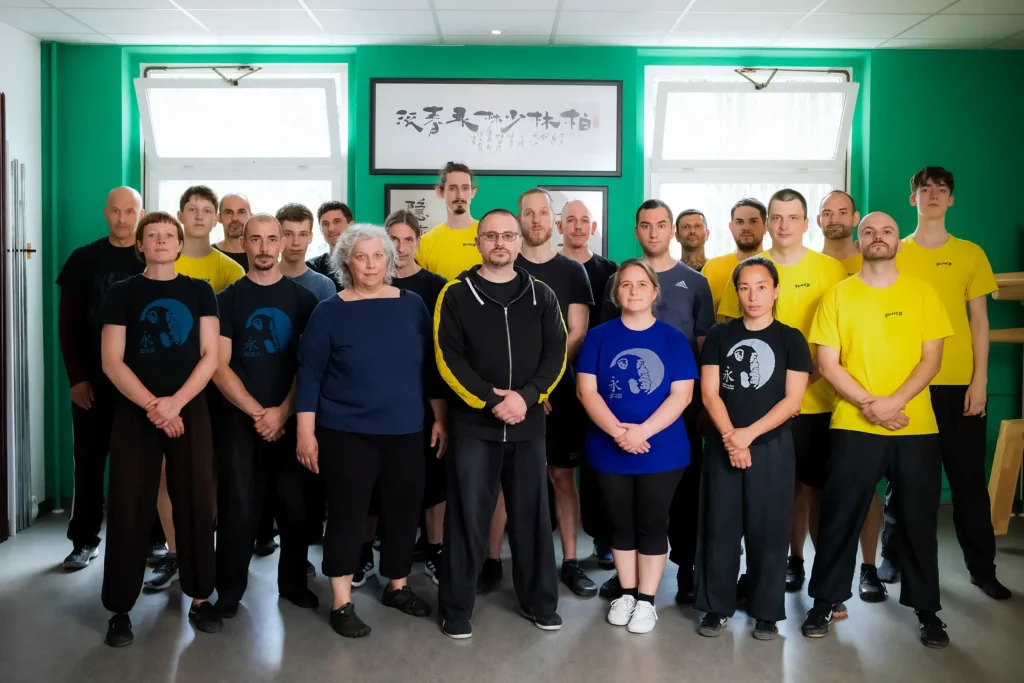
1997 to Present
Master Peter Scholz learned from 1997 to 2008 from Sifu Jörg Weidner of the lineage of Andreas Hoffmann, Cheng Kwong, Way Yan, and Lo Chiu Wun; in 2012 from Apolo Chiu of the Ignatius Siu, Chan Wing Yue, and Chu Chun Man lineage; from 2009 to 2018 from Michael Tang Chun Pak; and from 2018 onward from Peter Wong Wing Keung.
Bettina-Pela Scholz trained from 2001 to 2010 with Sifu Jörg Weidner, Sifu Michael Enzinger, and Sigung Andreas Hoffmann, all from the Cheng Kwong, Way Yan, and Lo Chiu Wun lineage.
Our school was founded in 2010 by Master Peter Scholz and Bettina Pela-Scholz at the Berlin location on Conrad-Blenkle-Straße 2 and expanded in 2023 to include the spaces at Conrad-Blenkle-Straße 3.
Since 2015, Peter Scholz has been working with his student, Hong Kong native and journalist Janet Yuen, on translating the handwritten records of the Siu Lam Wing Chun lineages.
In 2020, we established the online academy "Vade Mecum" to provide ongoing support for students and to assist teachers with their didactic methods.
Since 2019, our school has successfully participated in international competitions in the areas of hand forms, weapon forms, wooden dummy, point fighting, and Sanda.
Since 2023, the Open Ci Sau Workout has been held three times a week in our Powerbox, following the philosophy of open exchange seen in the Feilai Temple, the Red Boat, the Jyun Wo Percussion Shop, and the Dai Dak Lan.